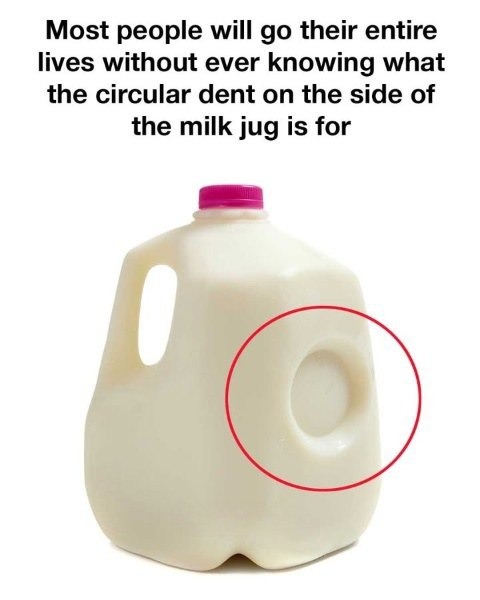Purpose of the Circular Dent on Milk Jugs.!
Milk travels a surprisingly long journey before it reaches your table. It moves from the dairy to a processing facility, then into a truck, then onto the shelves of a store, and finally into your refrigerator at home. During this trip the liquid never stays fully still. It warms up a little. It cools down again. It is shaken, tilted, and jostled. Each of these movements causes the milk inside the container to expand or contract. Although this change may seem tiny, the pressure inside the jug can rise and fall far more than people realize. If the plastic could not adapt, the container would warp, leak, or in rare cases even pop open. To prevent that kind of mess, the milk jug relies on a very simple but very clever feature that most people notice without understanding. The small circular indentation on the side of the jug quietly manages the pressure inside the container.
That unassuming circle works as a flexible pressure valve. When the milk warms up even slightly, the liquid expands and pushes outward. Instead of forcing the jug to stretch or split, the circle pops outward and absorbs the force. When the temperature drops again and the milk contracts, the circle settles back into place. This movement happens silently and reliably, often dozens of times before the jug ever reaches your refrigerator. The indentation behaves like a small cushion that protects the container from internal stress. Thanks to this simple shape, the jug remains intact through every shift in temperature. You never see the strain it absorbs, yet it prevents chaos that could easily happen during transport or storage.
The same rounded form also protects the jug from impacts. Milk containers are bumped, dropped, or knocked over more often than most people think. A smooth, flat wall of plastic would crack easily under sudden force. The concave circle, however, behaves like a shock absorber. It can push outward or pull inward to distribute energy from an impact across a larger area. This means the jug is less likely to crack when it hits a shelf, a shopping cart, or a kitchen floor. The design provides increased durability without requiring extra plastic. Instead of thickening the walls or adding complicated reinforcements, manufacturers rely on a simple geometric shape that offers strength through flexibility. A small indentation accomplishes the work of more material, which saves cost and reduces waste.
There is yet another advantage to this quiet feature. The circular dent offers a warning sign when something might be wrong with the milk. As milk spoils, bacteria inside begin to release gas. This gas builds pressure and pushes against the walls of the container. The indentation serves as the first point to react to that pressure. If the milk inside has begun to spoil, the circle will expand outward and remain puffed. A bulging dent can be an early clue that the contents are no longer safe to drink. It is not a perfect test, but it provides a simple visual cue that encourages caution before you pour.
This feature joins many other thoughtful details found in an everyday milk jug. The handle is shaped for easy pouring. The base includes ridges that improve stability. The caps are often color coded to signal fat content. When viewed together, these elements reveal a common container that is actually a small masterpiece of practical design, created to protect both the milk and the person who enjoys it.
